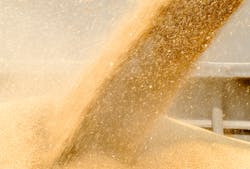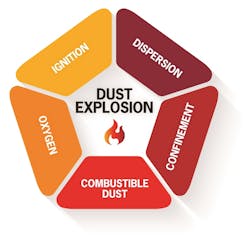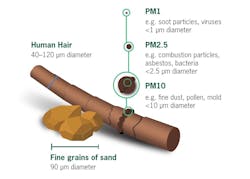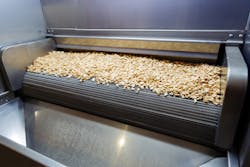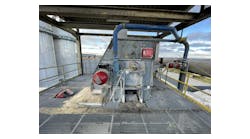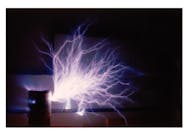Can it happen here? Dust hazards at food processing facilities
Dust produced during food processing can create significant safety and health hazards. Dust particles often become airborne and lead to fires and explosions. Airborne dust can also cause serious harm to human health and negatively impact the environment. In addition, particles can cross-contaminate other food products at the processing facility and proliferate the spread of pathogens and allergens. Common problematic food dusts include grain, flour, spices, cornstarch, sugar, tea, protein, soybean and flavoring additives.
This article takes a look at the challenges created by food dusts and how processors can safely capture, contain and control these particles.
Combustible dust
According to the 2021 Mid-Year Combustible Dust Incident Report — Version #1 by Chris Cloney at DustEx Research Ltd., from January through June 2021, there were 51 dust-related fires worldwide, with five injuries. During that same period, there were 28 dust-related explosions worldwide, 39 injuries and eight fatalities. The global data indicates that food products made up 44.3% of the recorded incidents, with 25 fires, 10 explosions, 18 injuries and four fatalities.
Five elements must be present for a dust explosion to occur: fuel, confinement, dispersion, oxygen and ignition. Therefore, a dust explosion can occur when a confined and concentrated combustible dust cloud comes into contact with an ignition source. Housekeeping tasks such as vacuuming can help remove dust from surfaces, but a properly designed and installed industrial dust collection system is necessary to thoroughly mitigate the threat, especially particles in the air.
It is important to understand that, when a dust collector pulls combustible dust from the air, the system itself can be a source of dust explosions if not properly protected with safety accessories. Just by doing its job, a dust collector creates an environment where four out of the five elements for an explosion are present.
Food dust is the fuel, and as it is pulled into the dust collector, it becomes confined. The pulse cleaning system that uses compressed air to blow dust off the filter cartridges can cause dispersion into a cloud formation. When this happens, the dust is mixed with oxygen-rich air. At this point, all that is needed for an explosion to occur is an ignition source, such as a spark from a misaligned conveyor belt, hot bearing or overheated motor. Once the dust ignites, the pressure inside the collector instantly rises. Unless the dust collector is equipped with the appropriate explosion protection, the housing can fragment and release a pressure wave, sending heat, flames and dangerous projectiles into work areas.
A dust collector that is National Fire Protection Association (NFPA) compliant and accurately designed, sized and installed to meet the needs of a specific food processing facility is the best protection against dust fires and explosions. The NFPA 652 standard requires that all facilities that produce or handle combustible dust complete a dust hazard analysis to comply with OSHA regulations.
Food dust exposure health hazards
Food dust is composed of organic and inorganic particles that can easily become airborne and be inhaled by workers. These particles in the air might not be noticeable but can be harmful. This is especially true for people who are allergic or intolerant to the matter or if they are exposed to the dust for a long period of time. Dust from raw food material can contain plant material, bacteria, insect parts and debris, endotoxins, fungal spores and pesticide residues. Many powdered additives can also cause fine dust that is dangerous if inhaled. Worker exposure can occur when handling food materials, such as during loading and unloading, drying, sifting, milling, grinding and mixing.
Particle matter (PM) with a diameter of 10 microns or less (≤ PM10) can reach the respiratory ducts, while particles 2.5 microns or less (≤ PM2.5) can lodge deep inside the lungs. Inhalable particles with a diameter of 1.0 micron or less (≤ PM1) can cause much more damage because they can penetrate the lung barrier and enter the blood system. Many of the particles produced by food processing are within this range. The nature and severity of the hazard will vary with the type of material being processed, how the material is handled and the length of exposure.
OSHA requires companies to control dust emissions in indoor workplaces and to comply with legal limits set for each ingredient and material. The agency has established Personal Exposure Limits (PELs) based on an eight-hour time-weighted average (TWA) for hundreds of dusts. If no legal limits are applicable, the company must define in writing, implement and measure its own environmental releases and develop a safety plan based on those results.
Airborne cross-contamination
Food contamination and foodborne illness cause recalls that cost food manufacturers hundreds of millions of dollars. Food dust traveling from one process area to another in a plant can cause a pathogen outbreak from the spread of microorganisms or allergen exposure from materials such as nuts or gluten.
Preventing cross-contamination requires effectively collecting and removing all contaminants before they become widely dispersed. Controlling, collecting, containing and properly disposing of food dust minimizes the spread of contaminants and keeps them from returning to the processing environment.
The FDA’s Food Safety Modernization Act (FSMA) requires food processing facilities to implement measures to prevent or minimize contamination hazards. Insufficient dust control can also hinder a facility’s compliance with the FDA’s Good Manufacturing Practices (GMPs) and Hazard Analysis and Critical Control Points (HACCPs).
Equipment to capture hazardous food dusts
High-efficiency cartridge-style dust collectors help food manufacturers meet safety compliance and quality controls regarding worker exposure and combustible dust management. Properly designed collectors capture dust by continually cycling the dust-laden airstream through a series of filter cartridges. The dust remains on the cartridges, and the clean air is returned to the work environment. The dust collector’s powerful pulse cleaning mechanism sends the dust into a hopper, where it can be safely removed.
Dust collection systems, along with properly designed ducting, capture food dust at the source using stainless steel pickup hoods at production stations. Whether attached directly to batch mixers or high-velocity slot hoods behind weigh stations, ducting pulls airborne particulates into the dust collector. Several other design features are used to control cross-contamination from food dust, including filter orientation, filter media, filter design and filter cartridge replacement method.
Industrial dust collectors can be placed inside or outside the manufacturing facility. If the facility is processing combustible dust, the safest option is to place the dust collector outdoors to vent away from buildings and populated areas in case of an explosion. However, it is not always feasible to place the collector outside. Dust collectors placed indoors must have the appropriate explosion protection systems if they will handle any combustible dusts.
Dust collector safety
It is important to have all collectors sized properly (with the correct air-to-media ratio) for the facility and applications they will be handling. Bear in mind that combustible dust explosions cannot always be prevented from occurring in the dust collector. However, systems can be put in place to lessen potential harm from an explosion.
A variety of explosion protection options are available, but the most common is explosion venting because it is a proven technology and is the most cost-effective. Most, if not all, dust collectors are required to have explosion isolation valves and may need to include integrated safety monitoring filters. If the collector is located inside the facility, a chemical suppression and isolation system may be required. All of these mitigate incidents and prevent the flame front and pressure from traveling to process areas. The NFPA provides guidelines to design, locate, install and maintain these explosion protection devices to minimize harm to personnel as well as structural and mechanical damage. It is important to note that, when a dust collector is protected properly, an explosion inside the unit is still possible but is safer than an explosion occurring in an unprotected dust collector system in an open facility or around workers.
Filter cartridges and media
Using the right filter cartridges based on the specific application and type of dust being collected ensures a safe work environment by minimizing worker exposure to hazardous airborne particles and serious combustible dust incidents.
There are two basic factors to consider when specifying dust collector filter cartridges: media type and fabrication technology. Filter media is the material or “fabric” used in the cartridge to capture dust particles. Generally, each cartridge contains hundreds of square feet of media folded up like an accordion, so it fits in a small space.
The base media is usually either a nonwoven blend called cellulose or a synthetic polyester or polyester silicone blend called spunbond. The cartridge can be designed to provide specific performance properties such as anti-stick, conduction, static dissipation and flame retardance.
Fabrication technology is the way in which the media is folded into the cartridge. This is important, because it impacts the performance of the collector and how long the cartridges last before needing to be replaced. For example, when the pleats are uniform across the entire media and held open with a plastic bead between the folds, more fabric is exposed to the airstream and available to capture dust particles as well as release those particles during the reverse pulse cleaning cycle.
Adding it all up to manage food process dust
Managers of food processing operations that generate dust must ensure good indoor air quality for the safety and health of employees, to reduce the risk of combustible dust fires and explosions and to prevent food dust from contaminating other products produced at the facility. Because dust control is a difficult challenge in industrial manufacturing and processing, it is critical to use a high-efficiency dust collection system that is custom designed and installed. It is also important to maintain the dust collection system so that it functions properly. When dealing with combustible dust, specifying the correct, NFPA-compliant explosion protection technology for your dust collector will minimize the risk of personnel injury and damage to your equipment and your facility.
David Steil is a Market Manager for Camfil Air Pollution Control, a manufacturer of dust and fume collection equipment for challenging industrial applications. For more information contact 800-479-6801 or email [email protected].
Camfil Air Pollution Control
